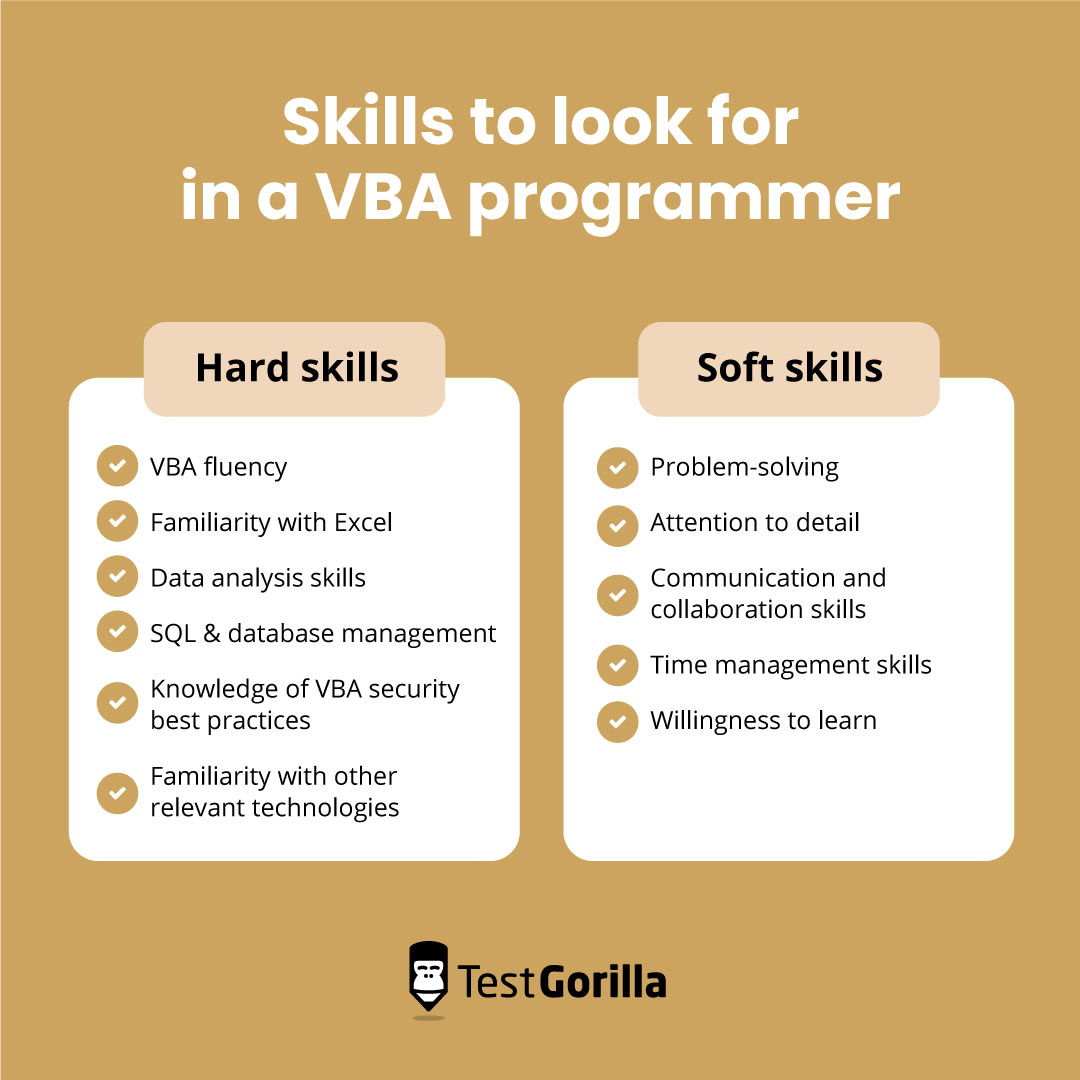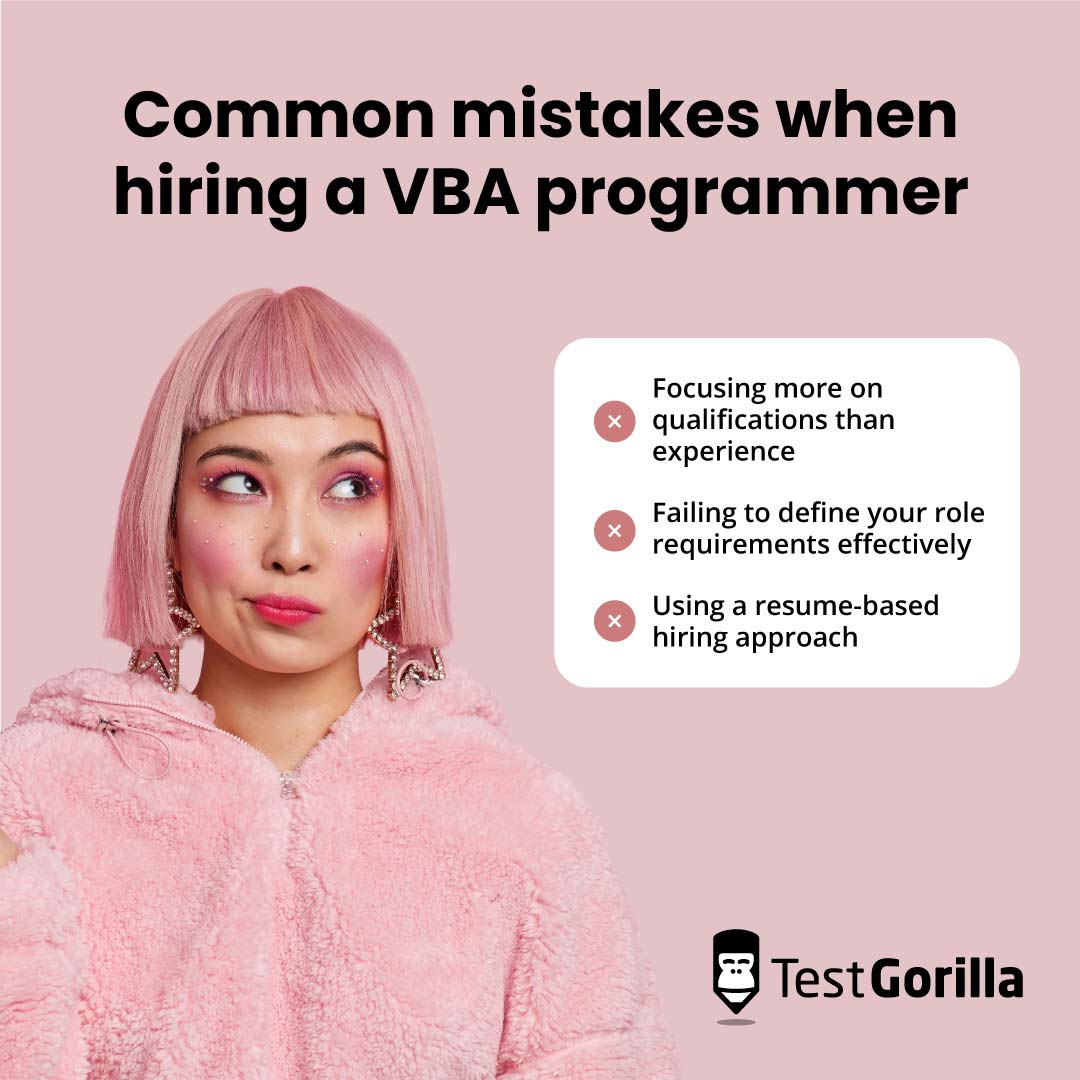Hiring a skilled VBA (Visual Basic for Applications) programmer can help you automate workflows and create custom solutions within Microsoft Office applications.
However, it’s not always easy to find the right individual to fill an open position, and making a mis-hire leaves your projects susceptible to inefficient automation, error-filled code, and missed deadlines.
Using a multi-measured, skills-based hiring approach is the best method to attract and identify top talent. Below, we explain everything you need to know about hiring a VBA programmer, how much you should pay, and how TestGorilla can help you attract and identify talented individuals.
Table of contents
What you need to know before hiring a VBA programmer
Before hiring a VBA programmer, you need to understand the requirements of your position, how candidates’ beliefs and values could align or conflict with your company culture, and what level of compensation you should offer.
Understanding role requirements
You need to understand every aspect of your VBA programmer position to ensure you’re able to hire the most suitable candidates. Here are a few points to think about:
Essential and preferred skills
Make sure you understand exactly what skills a VBA programmer must have, including those specifically required for your open position. For example, VBA fluency and a working knowledge of SQL for data analysis.
Necessary qualifications and/or experience
It’s also important to define exactly what qualifications or experience you’re looking for in a VBA programmer. For example, a college degree, an online certification, or working experience in a similar role.
You may also need to consider whether leadership or management skills are needed, depending on the role level.
Ensuring culture and personality fit
Hiring candidates whose beliefs and values align with your company culture can help make your workplace more productive, facilitating open communication and streamlined collaboration.
Cultural alignment can also reduce internal conflicts and staff turnover, making it easier to build a cohesive, collaborative team who are familiar with each other and comfortable working together.
Understanding what compensation you should offer VBA programmers
Offering competitive compensation and benefits like medical insurance or gym memberships will assist in attracting and retaining skilled employees.
There are numerous resources online that indicate how much you should be paying. For example, Glassdoor lists the average VBA programmer's annual salary (in the US) as approximately $82,000. It’s also a good idea to look at similar job postings to ensure you’re offering a similar or better level of compensation.
Skills and qualifications to look for in a VBA programmer
VBA programmers require a clear set of skills to be able to perform their tasks effectively.
Hard skills
Technical proficiency is at the heart of this role. Look for the following hard skills:
VBA fluency for writing clear, error-free code
Familiarity with Excel and other Microsoft Office programs
Data analysis skills for performing statistical analysis using VBA
SQL and database management skills for integrating VBA and database systems
Knowledge of VBA security best practices to ensure all code is clean and secure
Familiarity with other relevant technologies, including web scraping techniques and version control systems like GIT
TestGorilla enables you to assess these hard skills with tests such as the Visual Basic for Applications (VBA) test, the Microsoft Excel (General) test, and the Microsoft Excel (Advanced) test.
Soft skills
VBA programmers require a selection of soft skills for success when working alone or collaboratively. Look for the following:
Problem-solving to troubleshoot and overcome issues efficiently
Attention to detail for writing accurate, error-free code
Communication and collaboration skills to work well with team members, clients, and other relevant parties
Time management skills for working on multiple tasks simultaneously and meeting deadlines
Willingness to learn and keep up to date with evolving VBA concepts
Qualifications
A bachelor’s degree in computer science, IT, or a related field provides a solid base for VBA programmers. However, a formal degree isn’t essential, and many employers focus on skills, experience, and demonstrated proficiency.
VBA programming certifications, for example, can provide intensive, real-world training for the role, and self-study online courses offer a cost-effective way for self-motivated individuals to teach themselves.
The best insights on HR and recruitment, delivered to your inbox.
Biweekly updates. No spam. Unsubscribe any time.
Where to find skilled VBA programmers
VBA programmers are in high demand, and you’ll need to put some work in if you want to attract top talent. Let’s take a closer look at a few of the places you can find skilled candidates.
Online job boards
Creating a clear VBA programmer job description and posting it to online job boards, such as Indeed or LinkedIn, is a great place to start. This ensures that your position has maximum exposure and reaches a large number of candidates.
Freelance marketplaces
Freelance marketplaces, such as UpWork, provide access to a large pool of VBA programmers. Each freelancer has their own profile, which includes details about their skills and specialties and feedback from previous employers.
Most people use these marketplaces to fill short-term or temporary positions, but this method can also be used to attract permanent employees. Ensure you include the exact details of your position in your job posting to attract relevant candidates.
Online forums and communities
Specialist online forums and communities are excellent places to find talented VBA programmers. Websites such as Slack and Reddit are a great place to start, and it’s also worth looking for local and/or regional groups on social media.
Engaging with these communities and building relationships with skilled individuals creates a ready-to-use talent pool you can tap into when a position opens up.
Social media
You can use social media to find a skilled VBA programmer in two ways. First, you can advertise your position via platforms like Facebook or X (formerly Twitter). Using targeted advertising enables you to find potential candidates with a strong interest and/or skills in VBA programming.
You can also browse social media using hashtags related to VBA programming, such as #VBA or #Excel, to find potential candidates.
Two creative ways to find VBA programmer candidates
Here are two out-of-the-box approaches to finding VBA programmers other than posting on job boards.
Browsing the results of online competitions
There are numerous websites that offer online VBA and Excel programming competitions, such as FMWC. Browsing the results enables you to identify talented individuals, whom you can then reach out to via another channel.
For example, you could browse the results of past competitions or leaderboards for names that consistently appear, and then search their profile and connect with them on LinkedIn.
Company referral program
Offering a reward to employees who refer a successful candidate is a great way to source new talent. Your staff already understands what it’s like to work for your company, and they may be able to refer skilled candidates who will mesh well with your teams and share the same values and long-term goals.
How to select the best VBA programmer candidates
After you’ve posted your job online and gathered a pool of applicants for your VBA programmer position, you’ll need to start filtering them to identify the most appropriate candidates. Taking a multi-measure approach is the best way to do this, combining pre-employment testing with customized VBA programmer interview questions.
TestGorilla’s easy-to-use, all-in-one platform lets you assess and manage candidates at every step of the process and offers a wide range of soft and hard skills tests alongside personality assessments.
You can combine up to five pre-employment tests with your own custom interview questions to create a bespoke prescreening assessment. This can be shared with applicants via link or email, and you can view real time results through your TestGorilla dashboard.
Rank candidates according to their test results and assign your own grade and/or comments to custom questions. With these results, you can narrow your candidate pool with minimal effort, letting you focus on a handful of the most suitable applicants.
For a VBA programmer position, use the Visual Basic for Applications (VBA) and Microsoft Excel (Advanced) tests. Consider the following tests to assess soft skills and personality:
DISC test
Problem Solving test
Communication test
Time Management test
Once you’ve assessed candidates and shortlisted the most appropriate, use TestGorilla’s one-way video interview feature to conduct structured interviews.
Common mistakes when hiring a VBA programmer
Avoid these common mistakes to maximize your chances of hiring a skilled VBA programmer who fits your needs.
Focusing more on qualifications than experience
Although formal qualifications, such as a bachelor’s degree, can indicate a level of experience and training, not all skilled VBA programmers are formally trained. Because of this, you should focus more on each applicant’s experience rather than their formal education to accurately gauge how suitable they are for your position.
Failing to define your role requirements effectively
It’s crucial to clearly define the requirements of your position to ensure candidates know what role they’re applying for. If your job description is too generic or, even worse, inaccurate, you could find yourself swamped with unqualified applicants or few applications at all.
Using a resume-based hiring approach
VBA programmers come from a variety of backgrounds, and their resumes don’t always reflect their skills and experience. Using traditional screening methods rather than taking a multi-measured approach as outlined above, can result in overlooking talented individuals and hiring someone who’s not right for your position.
Use TestGorilla to hire a skilled VBA programmer
Understanding the ins and outs of your open position will help you hire the most suitable VBA programmer. Using a multi-measured, skills-based hiring approach will help you identify candidates who fit your needs.
With an extensive library of pre-employment tests, TestGorilla makes this easy. You can combine tests with custom interview questions to effectively screen candidates, and rank applicants based on their assessment results.
Give TestGorilla a try for free today, sign up for a free online demo, or check out the product tour to find out how our platform can help you hire the right VBA programmer.
You've scrolled this far
Why not try TestGorilla for free, and see what happens when you put skills first.

















